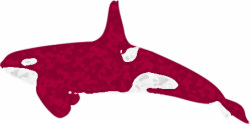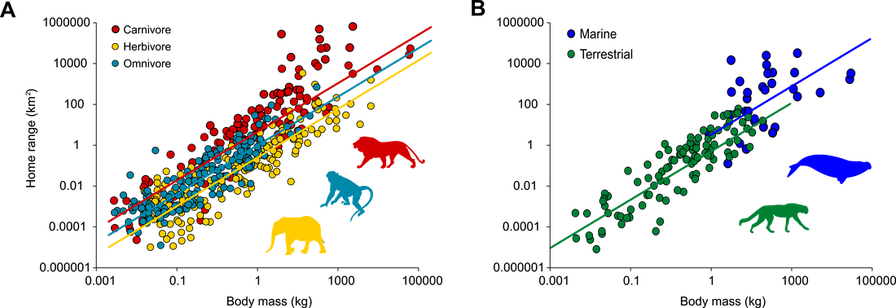Home Range: What are the drivers of mammalian home range patterns?
There is a strong positive relationship between body size and the area an animal lives within (home range), where larger species have larger home ranges. For example, an elephant requires a much larger area than a mouse in order to survive. This relationship is believed to be influenced by the costs associated with an animal’s metabolic needs and locomotion. In addition to body mass, diet and its influence on resource distribution and costs associated with food processing is thought to influence home range patterns. However, previous research has been limited with home range drivers examined in isolation, phylogenetic information has not been included into the analyses and the data used was biased towards terrestrial mammals.
I examined the relative contribution of physiological and ecological drivers on mammalian home range size. To do this, I used a two-step approach:
1) Re-evaluate the relationship between diet, body mass and home range size in terrestrial mammals within a
phylogenetic framework;
2) With a more comprehensive dataset including marine species, evaluate the role of environment, diet and body
mass on home range patterns.
Body size explains the majority of the difference in home range size among species (53–85%), where larger species occupy larger home ranges. Diet was also an important predictor of home range size (15% of variation), followed by the environment to a much lesser degree (1.7%).
I examined the relative contribution of physiological and ecological drivers on mammalian home range size. To do this, I used a two-step approach:
1) Re-evaluate the relationship between diet, body mass and home range size in terrestrial mammals within a
phylogenetic framework;
2) With a more comprehensive dataset including marine species, evaluate the role of environment, diet and body
mass on home range patterns.
Body size explains the majority of the difference in home range size among species (53–85%), where larger species occupy larger home ranges. Diet was also an important predictor of home range size (15% of variation), followed by the environment to a much lesser degree (1.7%).
The evolution of home range size has been driven by a range of factors, with both diet and body size having different relative contributions. In addition, the colonisation of the marine environment has resulted in the expansion of home range size. With broad-scale models often used to inform conservation strategies, the incorporation of phylogenetic information, a range of ecological variables, and the inclusion of species representative of the diversity within a group should is essential.
This work is in collaboration with Tracey Rogers and Terry Ord.
Publications
Tucker, M.A., Ord, T.J. & Rogers, T.L. (2014) Evolutionary predictors of mammalian home range size: body mass, diet and the environment. Global Ecology and Biogeography, 23, 1105-1114.
This work is in collaboration with Tracey Rogers and Terry Ord.
Publications
Tucker, M.A., Ord, T.J. & Rogers, T.L. (2014) Evolutionary predictors of mammalian home range size: body mass, diet and the environment. Global Ecology and Biogeography, 23, 1105-1114.
The Costs of a Carnivorous Lifestyle: Are all mammalian carnivores following the trend?

It is well established that terrestrial carnivorous mammals shift to feeding on larger sized prey when their body size is above 21kg in order to meet increasing energetic requirements. However, the relationship between energetics, prey size and carnivore body mass has not been investigated in marine carnivorous mammals. With the colonisation of the marine environment, changes to physiology and food resources have occurred and may have altered the relationship found on land.
I examined predator-prey body mass relationships across marine and terrestrial mammals including energetic requirements, within a phylogenetic framework.
By improving our understanding of the relationship between energetics and prey size and the drivers behind this relationship, we can better understand carnivore ecology and the influence
of carnivores on their ecosystems.
This work is in collaboration with Tracey Rogers and Terry Ord.
Publications
Tucker, M.A. & Rogers, T.L. (2014) Examining the Prey Mass of Terrestrial and Aquatic Carnivorous Mammals: Minimum, Maximum and Range. PLos One, 9, e106402.
Tucker, M. A., Ord, T. J., & Rogers, T. L. (2016). Revisiting the cost of carnivory in mammals. Journal of Evolutionary Biology, 29(11), 2181–2190. doi:10.1111/jeb.12936
I examined predator-prey body mass relationships across marine and terrestrial mammals including energetic requirements, within a phylogenetic framework.
By improving our understanding of the relationship between energetics and prey size and the drivers behind this relationship, we can better understand carnivore ecology and the influence
of carnivores on their ecosystems.
This work is in collaboration with Tracey Rogers and Terry Ord.
Publications
Tucker, M.A. & Rogers, T.L. (2014) Examining the Prey Mass of Terrestrial and Aquatic Carnivorous Mammals: Minimum, Maximum and Range. PLos One, 9, e106402.
Tucker, M. A., Ord, T. J., & Rogers, T. L. (2016). Revisiting the cost of carnivory in mammals. Journal of Evolutionary Biology, 29(11), 2181–2190. doi:10.1111/jeb.12936
Caught in the web: Predator-prey relationships, trophic level and body mass in mammals.
The association between trophic level and body mass, as well as the relationship between trophic level and the predator-prey body-mass ratios are often used to investigate the feeding ecology of carnivorous species. There has been limited research on these relationships in mammals, with previous research incorporating few mammals species and largely excluding large species (>10 000 kg), who are highly vulnerable to population declines.
My aim was to investigate how the colonisation of different environments has impacted mammalian feeding ecology. To achieve this I examined:
1) What has driven the evolution of trophic-level-body-mass patterns in carnivorous mammals;
2) Whether living in different environments resulted in the diversification of particular diet categories (across carnivores,
omnivores and herbivores) in mammals;
3) What have been the drivers behind these patterns.
My aim was to investigate how the colonisation of different environments has impacted mammalian feeding ecology. To achieve this I examined:
1) What has driven the evolution of trophic-level-body-mass patterns in carnivorous mammals;
2) Whether living in different environments resulted in the diversification of particular diet categories (across carnivores,
omnivores and herbivores) in mammals;
3) What have been the drivers behind these patterns.
Information on mammalian feeding ecology has the potential to provide insights into the structure and functioning of marine and terrestrial communities.
This work is in collaboration with Tracey Rogers.
Publications
Tucker, M.A. & Rogers, T.L. (2014) The effects of environment and body size on mammalian feeding ecology. Proceedings of Royal Society B: Biological Sciences, 281 (1797).
This work is in collaboration with Tracey Rogers.
Publications
Tucker, M.A. & Rogers, T.L. (2014) The effects of environment and body size on mammalian feeding ecology. Proceedings of Royal Society B: Biological Sciences, 281 (1797).


